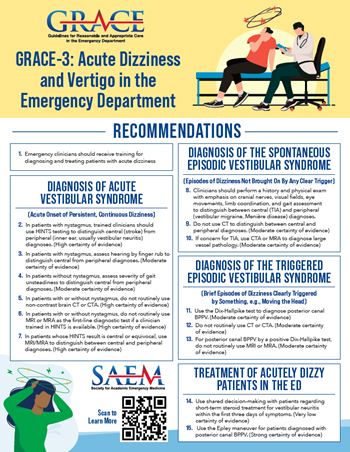GRACE-3

The SAEM GRACE program addresses the best practices for the care of the most common chief complaints that can be seen on the tracking board of any emergency department in the country, based upon research and expert consensus. These guidelines are designed with de-implementation as a guiding principle to reasonably reduce wasteful testing, provide explicit criteria to reduce foreseeable risk, and define sensible and prudent medical care.
GRACE-3: Acute Dizziness and Vertigo in the Emergency Department
Acute dizziness or vertigo is a common emergency department (ED) presentation, accounting for 2.1%–3.6% of visits per year, with an estimated annual cost approximating $10 billion in the United States, a large proportion of which is related to imaging.
The traditional diagnostic approach for these patients was developed 50 years ago and is based on symptom reports (asking patients “What do you mean by dizzy?”). Newer evidence suggests that a diagnostic paradigm based on the timing and triggers of dizziness rather than symptom quality is more useful. The GRACE-3 clinical practice guideline has been developed to address the critical need for evidence-based recommendations for the care of patients presenting in the emergency department with acute dizziness and vertigo.
Most acutely dizzy patients in the ED present in one of three patterns that drive the differential diagnosis, diagnostic testing, and the interpretation of many of these tests.
- Acute vestibular syndrome (AVS) - acute onset of persistent, continuous dizziness lasting longer than 24 hours
- Spontaneous episodic vestibular syndrome (s-EVS) - episodes of dizziness not brought on by any clear trigger
- Triggered episodic vestibular syndrome (t-EVS) - brief episodes of dizziness clearly triggered by something, e.g., moving the head
The GRACE-3 multidisciplinary panel applied the Grading of Recommendations Assessment, Development, and Evaluation (GRACE) approach to assess the certainty of evidence and strength of recommendations regarding five questions for adult ED patients with acute dizziness of less than two weeks' duration.
PICO Questions
1. Should adult ED patients presenting with acute, continuous prolonged dizziness/vertigo (the acute vestibular syndrome [AVS]) undergo neuroimaging to diagnose stroke in the ED, or should they be diagnosed through bedside examination without neuroimaging? If yes to neuroimaging, what type of imaging? If no to neuroimaging, what type of bedside examination?
2. Should adult ED patients presenting with spontaneous episodes of dizziness/vertigo (the s-EVS) undergo neuroimaging to diagnose transient ischemic attack (TIA) in the ED, or should they be diagnosed through bedside examination without neuroimaging? If yes to neuroimaging, what type of imaging? If no to neuroimaging, what type of bedside examination?
3. Should adult ED patients presenting with triggered episodes of dizziness/vertigo (the t-EVS) undergo neuroimaging to diagnose stroke in the ED, or should they be diagnosed through bedside examination without neuroimaging? If yes to neuroimaging, what type of imaging? If no to neuroimaging, what type of bedside examination?
4. Should adult ED patients diagnosed with vestibular neuritis be treated with steroids?
5. Should adult ED patients diagnosed with pc-benign paroxysmal positional vertigo (BPPV) be treated with the Epley maneuver?
Recommendations
The GRACE-3 panel developed 15 evidence-based recommendations based on the timing and triggers of dizziness, while recognizing that alternative diagnostic approaches exist.
Training Emergency Clinicians to Perform Bedside Eye Movement Examinations
1. Emergency clinicians should receive training for diagnosing and treating patients with acute dizziness.
Diagnosis of AVS
2. In patients with nystagmus, trained clinicians should use HINTS testing to distinguish central (stroke) from peripheral (inner ear, usually vestibular neuritis) diagnoses. (High certainty of evidence)
3. In patients with nystagmus, assess hearing by finger rub to distinguish central from peripheral diagnoses. (Moderate certainty of evidence)
4. In patients without nystagmus, assess severity of gait unsteadiness to distinguish central from peripheral diagnoses. (Moderate certainty of evidence)
5. In patients with or without nystagmus, do not routinely use non-contrast brain CT or CTA. (High certainty of evidence)
6. In patients with or without nystagmus, do not routinely use MRI or MRA as the first-line diagnostic test if a clinician trained in HINTS is available. (High certainty of evidence)
7. In patients whose HINTS result is central or equivocal, use MRI/MRA to distinguish between central and peripheral diagnoses. (High certainty of evidence)
Diagnosis of s-EVS
8. Clinicians should perform a history and physical exam with emphasis on cranial nerves, visual fields, eye movements, limb coordination, and gait assessment to distinguish between central (TIA) and peripheral (vestibular migraine, Menière disease) diagnoses.
9. Do not use CT to distinguish between central and peripheral diagnoses. (Moderate certainty of evidence)
10. If concern for TIA, use CTA or MRA to diagnose large vessel pathology. (Moderate certainty of evidence)
Diagnosis of the Triggered Episodic Vestibular Syndrome
11. Use the Dix-Hallpike test to diagnose posterior canal BPPV. (Moderate certainty of evidence)
12. Do not routinely use CT or CTA. (Moderate certainty of evidence)
13. For posterior canal BPPV by a positive Dix-Hallpike test, do not routinely use MRI or MRA. (Moderate certainty of evidence)
Treatment of Acutely Dizzy Patients in the ED
14. Use shared decision-making with patients regarding short-term steroid treatment for vestibular neuritis within the first three days of symptoms. (Very low certainty of evidence)
15. Use the Epley maneuver for patients diagnosed with posterior canal BPPV. (Strong certainty of evidence)
Read the Guideline in AEM
GRACE-3 Infographic
Upcoming GRACE Guidelines
GRACE-5: Syncope (2024)

